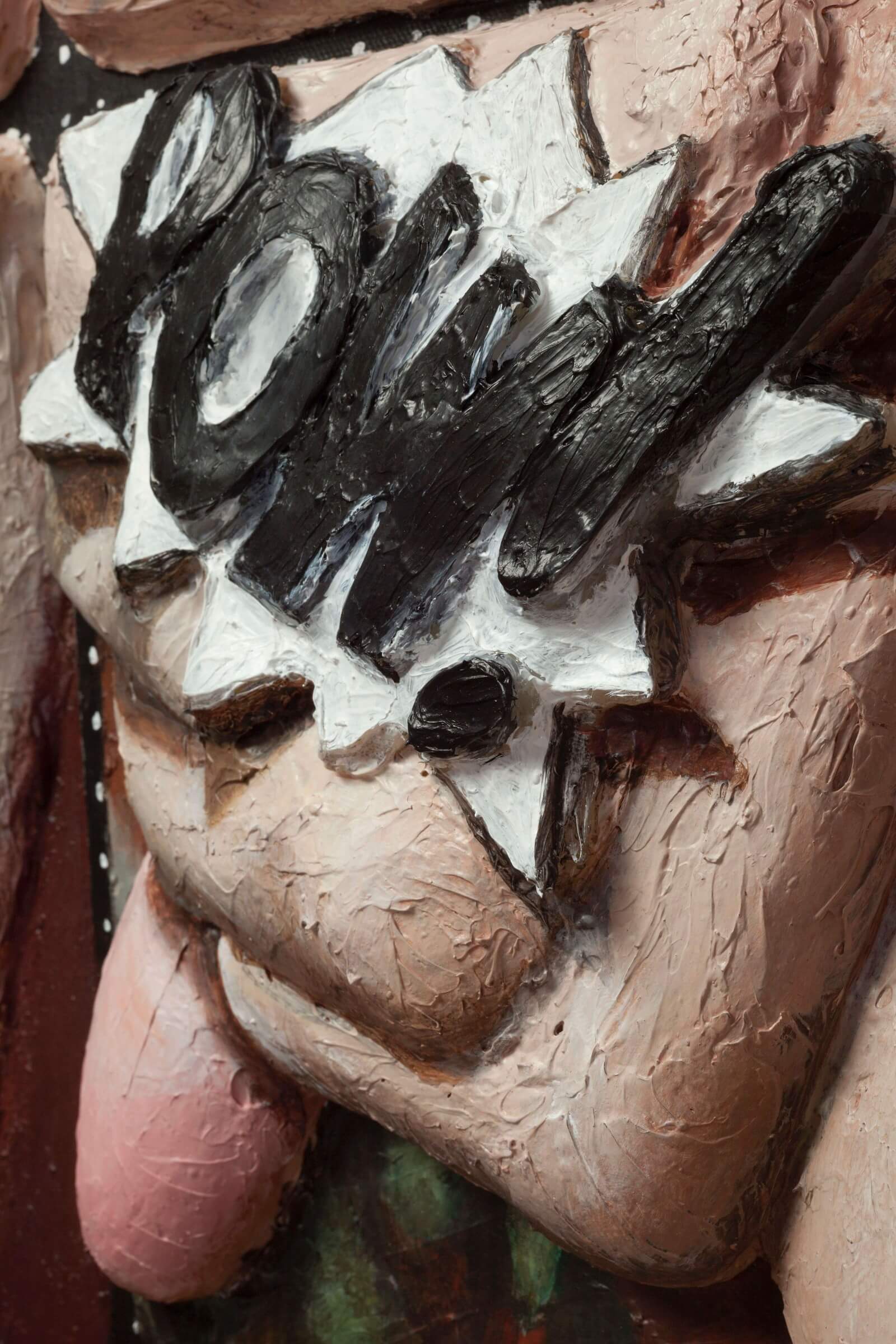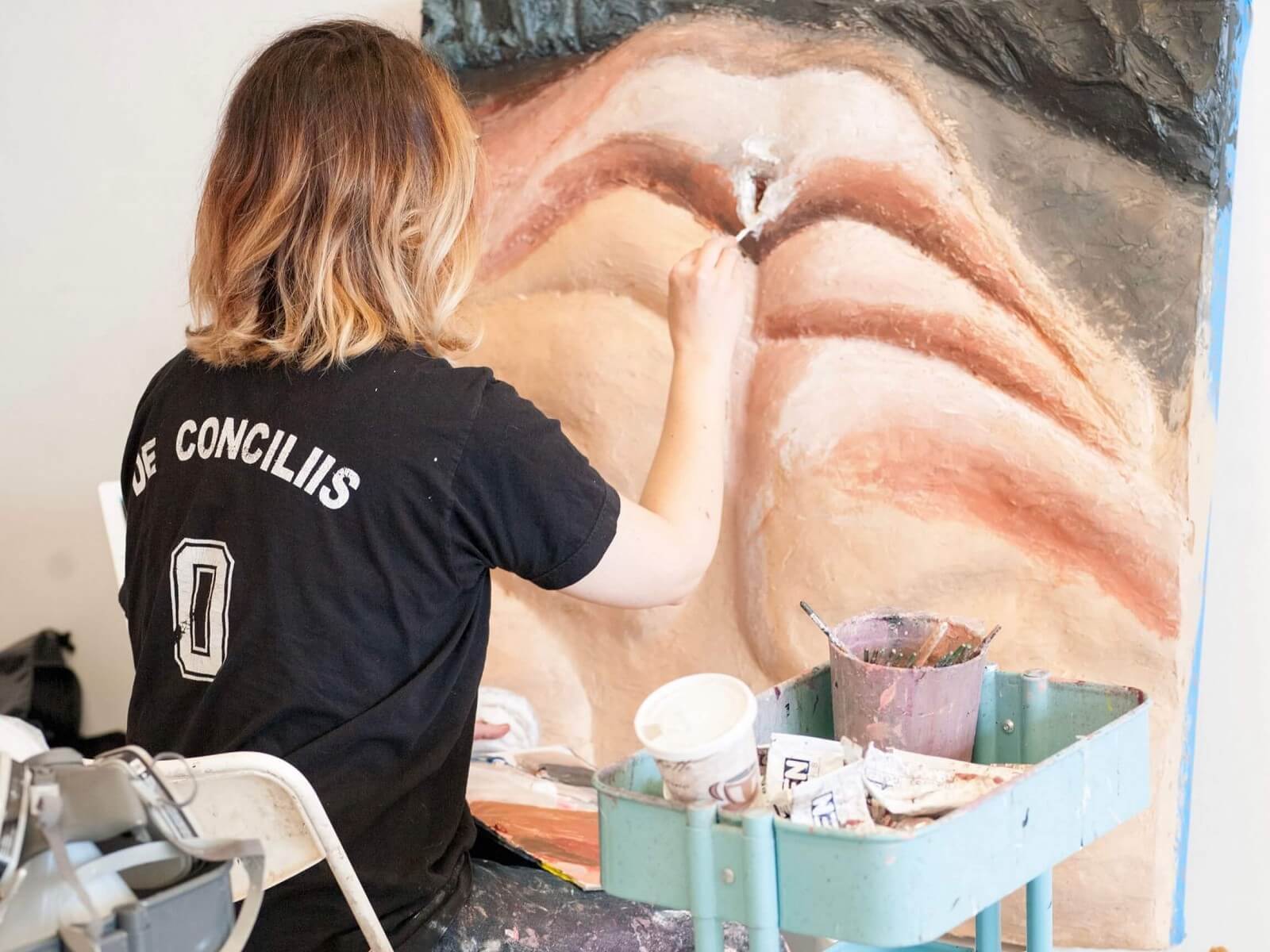Gina Beavers
Ambitchous
➝ German Press Release
➝ Download Press Release
The process of digitization has radically altered the political, economic, and cultural function of the image – there can be no doubt about that. It remains to be seen if, and on what plane, art is capable of sustainably responding to this regime as a social site of reflexive image production, and the extent to which it can create images which have the strength to resist the normalizing tendency of digital codes (after all, codes do not tolerate substantive argument).
According to the universal rule of the media-theorist Marshall McLuhan, the “content of any medium is always another medium” (Understanding Media: The Extensions of Man, 1964). With this in mind, it can certainly be assumed that within digital media, neither (over)affirmative nor critical interrogations of new technologies, their means of image production and/or their social consequences will be capable of communicating a sufficiently complex depiction of this new regime to society – even if such strategies might expand the spectrum of conceivable and pre-existing images within it. But a reflection of the structure – which is the prerequisite for images coming to be understood and utilized in a fundamentally different way – requires detachment, a sense of removal, and one of the ways in which this becomes possible is through a change of art form.
Against this backdrop, the American artist Gina Beavers focuses on the uniform, “affect-hungry” visual language of the internet, using the (perhaps ostensibly unsuited) medium of panel painting. The impact of a painting is founded on its singularity (by definition, no picture/series of pictures is identical to another) and a duration of time, which has to bestow the parallel planes of perception present in the picture in a temporal sequence over the course of the act of viewing. In this sense, it is in principle opposed to how a digital image typically operates. However Beavers makes use of this discrepancy by singling out just one image from millions of similar photos – for example, from the popular genre of ‘food porn’, which charges photographs of lavishly prepared meals with (sexual) desire, or from the deluge of make-up tutorials which regulate the self-image of women – to translate it into a painting. In subjecting this image to another logic, she divests it of its natural quality and uses painting as an analytical tool. The viewer is no longer looking at photographic tableaus composed of freeze-frames taken from make-up tutorials, but rather paintings about make-up tutorials, which present the aesthetic and formal parameters of this particular class of images, which exist exclusively on the net.
The unvarnished quality of these paintings is at once attractive and repulsive: really, the images are too direct, they reveal their made-ness too cheaply, seem too calculated and sensationalist to be viewed as simply “beautiful”. Interestingly though, it is precisely these qualities which arouse the desire to nevertheless look at the images, as if Beavers were tempering their sexiness with a dash of vulgarity, and through this, augmenting the (perverse?) pleasure in the paintings.
In her current exhibition, conventional make-up instructions for applying lipstick or eyeshadow are juxtaposed with carnivalesque instructions for dressing up as cartoon characters, such as the legendary bio-exorcist Beetlejuice, the nasty fashion designer Cruella de Vil from the Disney classic 101 Dalmatians, or the Snow Queen Elsa from the animated adaptation of the eponymous Hans Christian Andersen fairy tale. So it isn’t protagonists with positive connotations which are favoured by the artist, but unmistakably ambivalent characters who could undoubtedly lay claim to the neologism ambitchous, which is the name given to the exhibition. Like the original image material, this portmanteau of ‘ambitious’ and ‘bitchy’ is taken from social media and its creative vernacular, and is used, depending on the context, either in a derogatory fashion – for example for women who will do absolutely anything to get what they want – or positively re-interpreted as an expression of female self-affirmation.
Beavers also applies this playful and strategic complication of seemingly unambiguous contexts of meaning to the statements contained in her paintings. It remains utterly impossible to determine whether they are critically exaggerating the conformist and consumerist beauty ideals of neo-capitalism, or ascribing emancipatory potential to the conscious and confident use of make-up.
The switch in media proves to be just as ambiguous, leading to a shift in the relationship between image and viewer. Even if the subject matter remains identical, the masses of made-up eyes and lips no longer recur exclusively on perfected and/or costumed bodies implicitly promising the gratification of narcissistic fantasies. Rather they become partial objects which long to be seen, touched and desired themselves. In this way, the painting activates itself and rejects immediate gratification in favour of a mutual attraction which demands more concentrated attention from the viewer, but in exchange leaves a more lasting impression.
Even more decisive though in achieving this effect is the aggressive materiality of the paintings. Beavers applies un-thinned acrylic paint to the canvas in so many layers that the forms begin to emerge from the surface like a relief. Eyelashes, eye-lids, eye-brows and lips are to an extent not just depicted, but mimicked in their objecthood. Eyes do not just appear to peek out from the paintings, they genuinely do so; mouths do not just seem voluptuously curved, but in actual fact bulge toward the viewer.
Nevertheless there is nothing naturalistic about the paintings, rather they exaggerate the comic-like artificiality of the serial close-ups from the original image material, and convey – perhaps similarly to poster art precisely through their conscious distance from reality – a more vivid impression than a 3D rendering, for instance, could ever achieve.
Elements such as brushes, lipsticks or fingers, which are intended to reassure the viewers of the videos of the imitability of the make-up procedures, here allude to the active role of the painting – which does not just stare or make eyes at the viewer, but rather seems to paint itself with the accessories depicted – literally building a bridge extending out from the image. Suspended between painterly illusion and sculptural presence, the work does not allow the gaze to come to a rest, and the body as well is compelled to respond to the direct address of the countless provocative eyes and mouths.
Above all, this calculated unsettling effect creates a distance from habitual patterns of perception, and makes the viewer conscious of the fact that what is depicted in an image is always already fused with the emotions it produces or seeks to produce – and that this structure is not, for example, something that is specific to the ‘post-truth’ world. Truth and desire have never been independent, objective values, since they are interdependent insofar as truth only becomes a relevant category for us when it directly or indirectly affects us and vice versa. It must be continually constructed anew in and for every specific situation.
Therefore it is not the relation between image and reality that is problematic, but rather the mode of connecting images with each other. Increasingly, algorithms which exclusively create relationships between images according to similarity (for example, hashtags) are determining the connections that we (are able to) see, reducing contexts to what can be expected (and marketed). Unforeseen leaps or unlikely connections – all those combinations which a more complex form of perception would afford – are lost in the process. The task of art will be to provide us with an awareness of this self-imposed loss, and to develop alternative forms of reference. And this is precisely the direction in which Gina Beavers’ art embarks.
by Ellen Blumenstein

Additional Information

Gina Beavers’ primary source of inspiration is the ubiquitous contemporary visual culture, especially the one emerging from social media. Dealing initially with references taken from the original pop movement of the 1950s, Beavers evolved to paint the ‘current pop,’ starting to search on social media for image templates to her extravagant, thickly layered relief-like acrylic compositions. Beavers’ anthropological interest in society translates in paintings that explore the banality of internet: makeup tutorials, the so-called food-porn pictures, body builder selfies. In tune with the eccentricity of her artistic process, the artist maximizes the visual potency of her medium, taking tridimensionality to its higher possible level and bringing painting closer to some sort of sculpture.
In 2019 Beavers had a solo exhibition at MoMA PS1, and in 2020 she was part of a group show in the Frans Hals Museum, in Haarlem. She has a BA in Studio Art and Anthropology, and a MFA in Painting and Drawing. Her work is part of permanent collections, such as the Institute of Contemporary Art Miami (USA), The Tel Aviv Museum of Art (Israel), and the Whitney Museum of American Art (USA). Born in 1978 in Athens, she currently lives and works in New York.
